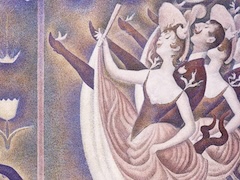Vase of Flowers by Georges Seurat

Despite its relatively dull colors, this early canvas contains in germ much of Seurat's future color practice. It is based on the contrasts of hue and the broken rather than uniform colors that were at the center of his readings about Delacroix and color theory. He began with wide crisscross strokes of dark tones which he allowed to dry, so that subsequent layers, picking up just the ridges of these strokes, left the valleys partly exposed. This assured both a binding matrix and a shimmer of light and dark that activated the surface. For the background, vaguely resembling cloth, he then applied several colors in short vertical strokes: wine red, blue, brick red, dull orange, and brown. The backdrop turns dark or light to contrast with the opposite tonality of the vase and flowers; it also accumulates more green and blue to oppose nearby reds and oranges. For the darker base of the bouquet, greens become prominent in opposition to the mixture of reds and yellows of the blossoms; those greens (medium green, yellow-green) are partly mixed with pink, cream, and dark blue.
The vase has a grayish cream local color with a pale green floral pattern, but these are largely obliterated by the strong direct light and, on the extreme right, by a narrow zone of orange tints that represents light reflected from the illuminated tablecloth. In reaction to that orange zone, the vase has a parallel band of "gray," consisting of blue and green.
















